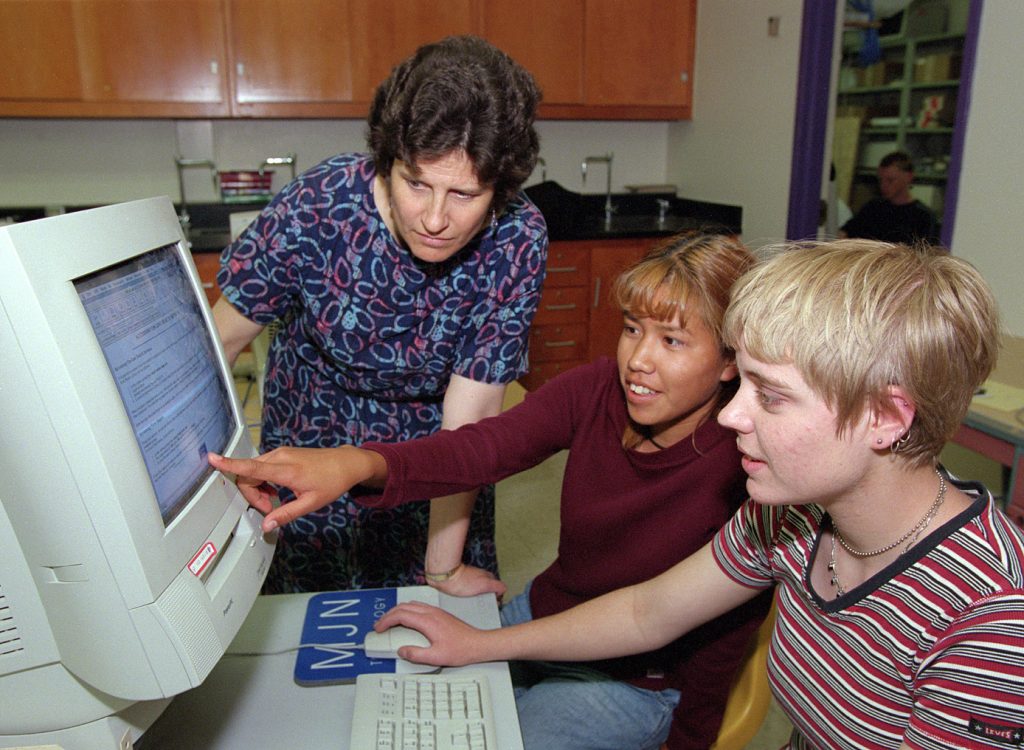
Download 150dpi JPEG image, ‘webtext.jpg’, 1.4Mb
ALBUQUERQUE, NM — Imagine a school in the 21st century where students carry no books and study from a virtual textbook.
That future may be closer than you think. A mathematician from the Department of Energy’s Sandia National Laboratories and two teachers have developed a completely Web-based textbook currently being used in 100 middle and high schools in nine states to teach students computational science. Twenty-eight of the schools are in New Mexico.
“This textbook is unique because it is strictly on-line,” says Dick Allen of Sandia’s Computational Education Programs. “Students look at the textbook on the Web and do their reading, studying, and problem solving from it. There is a teacher’s manual with links to lesson plans, solution keys, assessment tools, and national/state standards. And the joy of it is that it’s available free to anyone with Internet access.”
Allen, along with Paula Avery, a computer science teacher at Moriarty High School, and Jill Wallace, a former math and computational science teacher at Albuquerque High School, created the book for the Department of Energy’s (DOE) seven-year-old Adventures in Supercomputing (AiS) program.
AiS brings computational science into the middle and high schools by joining teachers with science mentors, offering extensive in-service training and follow-up workshops, teaching materials, technical assistance, and professional development. Students work on long-term projects that require them to pose hypotheses, develop mathematical models to solve problems using a computer, and analyze their results.
The goal of the program, Allen says, is to get diverse populations of students interested in computational science, a problem-solving environment that integrates science and engineering with computing and mathematics. The five-state program is sponsored in New Mexico by Sandia.
Teachers like Ellen Loehman at Manzano High School are finding their students excited about learning computational science and participating in AiS. Loehman says that Manzano initially joined three years ago because the school received four free computers and an Internet connection for participating. However, they’ve stayed because of the popularity of the program and the increasing emphasis on school-to-work programs. Being an AiS school has driven the use of technology at Manzano and other AiS schools.
For Loehman, the Web textbook is an important resource for her students.
“The only textbook available devoted to the subject is this on-line version. I’d have a real difficulty teaching the class without it,” she says.
Her students accessed the textbook to help them with their computational projects, which ranged from analyzing data to determine what would happen to animal populations in Yellowstone National Park if the wolf were restored to the wild, to computing mathematically how to get the perfect golf shot.
The virtual textbook, which can be found at AiS’s web site at http://ais.cs.sandia.gov/AiS/textbook/textbook.html, was recently nominated for a Computerworld Smithsonian Award, an honor that Computerworld magazine and the Smithsonian Institution present annually to individuals whose visionary use of information technology produces positive social, economic, and educational change.
Allen says that he, Avery, and Wallace spent more than two years developing the textbook.
“The Web textbook was completely teacher driven,” Allen says. “After participating in the initial AiS training in 1992 and attempting to implement a computational science course in their respective secondary schools, teachers told us they needed more resources and materials that would support their efforts. They especially wanted a well-defined curriculum — a textbook.”
The three decided to put the textbook on the Web, instead of printing hard copies because they believed that the use of hyperlinks would allow users to reach beyond the limitations of a traditional printed textbook, expanding the scope, depth, and quick access to related information.
They also knew that the field of computational science was changing so rapidly that textbooks on the subject would have to be revised frequently.
“Desiring to avoid writing a textbook that was obsolete as soon as it was published, we chose a Web-based medium that allows for easy access and inclusion of ongoing technology advances,” Allen says.
Sandia is a multiprogram DOE laboratory, operated by a subsidiary of Lockheed Martin Corp. With main facilities in Albuquerque, N.M., and Livermore, Calif., Sandia has major research and development responsibilities in national security, energy, and environmental technologies and economic competitiveness.
Note: The following high schools in New Mexico use the Web-based textbook: Alamogordo, Albuquerque, Carlsbad, Cimarron, Bernalillo, Cibola, Clovis, Del Norte, Estancia, Highland, Gasden, Las Cruces, Mayfield, Mescalero, Onate, Los Lunas, Manzano, Moriarty, Pecos, Santa Fe, St. Michael’s, Vaughn, Silver, Tularosa, West Las Vegas, West Mesa, and Albuquerque Evening School. Also, Estancia Middle School.
Technical contact:
Dick Allen, rcallen@sandia.gov, (505) 845-7825